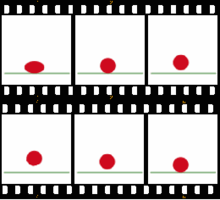Portal:Animation

| Main | Categories and topics | Tasks and projects |
Introduction
Animation is a filmmaking technique by which still images are manipulated to create moving images. In traditional animation, images are drawn or painted by hand on transparent celluloid sheets (cels) to be photographed and exhibited on film. Animation has been recognized as an artistic medium, specifically within the entertainment industry. Many animations are computer animations made with computer-generated imagery (CGI). Stop motion animation, in particular claymation, has continued to exist alongside these other forms.
Animation is contrasted with live-action film, although the two do not exist in isolation. Many moviemakers have produced films that are a hybrid of the two. As CGI increasingly approximates photographic imagery, filmmakers can easily composite 3D animations into their film rather than using practical effects for showy visual effects (VFX). (Full article...)
Selected article
"Cartman Gets an Anal Probe" is the first episode of the American animated television series South Park. It was originally broadcast on Comedy Central in the United States on August 13, 1997. The episode introduces child protagonists Eric Cartman, Kyle Broflovski, Stan Marsh and Kenny McCormick, who attempt to rescue Kyle's younger brother Ike from abduction by aliens. At the time of the writing of the episode, South Park creators Trey Parker and Matt Stone did not yet have a series contract with Comedy Central, and Parker later commented that they felt "pressure" to live up to the internet shorts that first made them popular. Short on money, the duo animated the episode using cut paper stop motion techniques. As such, "Cartman Gets an Anal Probe" remains the only South Park episode animated without the use of computer technology. When the episode was first broadcast in Canada, "objectionable" material was cut; it was later restored in subsequent showings. Initial reviews of the episode were generally negative; critics singled out the gratuitous obscenity of the show for particular scorn and compared South Park unfavorably with what they felt were the more complex and nuanced The Simpsons and Beavis and Butthead.
Selected image

Did you know (auto-generated) -

- ... that the live-action comedy series Community had a stop motion animated Christmas special?
- ... that although Blizzard's franchise Overwatch is centered around video games, its lore is mainly told through animated shorts, comics, and novels?
- ... that Raoul Servais invented a new technique for combining animation and live action for his short film Harpya?
- ... that according to an elaborate 1990s joke, Elmo Aardvark was history's first animated cartoon character?
- ... that "Arnold's Christmas", now considered one of the most memorable episodes from the animated series Hey Arnold!, was almost rejected by network executives because it depicted the Vietnam War?
- ... that the interactive cartoon Cat Burglar takes about 15 minutes to watch, but features 90 minutes of animation?
Selected quote
Selected biography
Julie Kavner (born September 7, 1950) is an American film and television actress, comedian and voice artist. Noted for her role as Marge Simpson on the animated television series The Simpsons, she also voices other characters for the show, including Patty and Selma Bouvier. Born in Los Angeles, Kavner grew up in Southern California, attending Beverly Hills High School and later San Diego State University. Known for her improvisation and distinctive "honeyed gravel voice," Kavner was cast in her first professional acting role as Brenda Morgenstern in Rhoda in 1974. She received a Supporting Actress in a Comedy Series Primetime Emmy Award in 1978 and several more award nominations for playing the character. Following Rhoda, Kavner was cast in The Tracey Ullman Show, which debuted in 1987. The Tracey Ullman Show included a series of animated shorts about a dysfunctional family. Voices were needed for the shorts, so the producers decided to ask Kavner to voice Marge. The shorts would eventually be spun off into The Simpsons.
Selected list
The episodes of Adventure Time, an American animated television series created by Pendleton Ward (pictured) for Cartoon Network. The series follows the adventures of Finn (voiced by Jeremy Shada), a human boy, and his best friend and adoptive brother Jake (voiced by John DiMaggio), a dog with magical powers to change shape and grow and shrink at will. Finn and Jake live in the post-apocalyptic Land of Ooo. Along the way, they interact with the show's other main characters: Princess Bubblegum (voiced by Hynden Walch), the Ice King (voiced by Tom Kenny), and Marceline the Vampire Queen (voiced by Olivia Olson). The show originally began in 2008 with a pilot for Random! Cartoons on Nicktoons Network. The pilot quickly became a cult hit on YouTube. After Nickelodeon declined to turn the short into a full-fledged show, Cartoon Network purchased the rights, and Adventure Time launched as a series on April 5, 2010. Adventure Time is produced by Cartoon Network Studios and Frederator Studios. The series is rated TV-PG. Several compilation DVDs have been released. Ever since its debut, Adventure Time has been a ratings success for Cartoon Network. As of March 2012, the show is viewed by approximately 2 to 3 million viewers per week. The show has received positive reviews from critics and has developed a strong following among teenagers and adults, many of whom are attracted due to the series' animation, stories, and characters.
More did you know...
- ...that Milt Gross, writer of comics that used Yiddish-inflected English, also wrote a 1930 "silent" graphic novel He Done Her Wrong: The Great American Novel and Not a Word in It — No Music, Too?
- ...that Gustaf Tenggren was a chief illustrator at the Disney Company when Snow White and the Seven Dwarfs (pictured), Bambi and Pinocchio were produced?
- ...that Virgil Walter Ross animated Bugs Bunny and Daffy Duck for decades under Tex Avery and Fritz Freleng and received the highest awards in his profession?
Anniversaries for May 19
- Films released
- 1934 – Gulliver Mickey (United States)
- 1939 – Donald's Cousin Gus (United States)
- 1945 – Ain't That Ducky (United States)
- 1950 – Primitive Pluto (United States)
- 1951 – Rabbit Fire (United States)
- 1956 – Tree Cornered Tweety (United States)
- 2000 – Dinosaur (Walt Disney Pictures, United States)
- 2004 – Shrek 2 (DreamWorks Animation, United States)
- Television series and specials
- 2006 – Fairy Idol, a television special airs on Nickelodeon
- 2019 – Star vs. the Forces of Evil, an American animated television series finishes airing on Disney XD
Subportals
Related portals
Wikimedia
The following Wikimedia Foundation sister projects provide more on this subject:
-
Commons
Free media repository -
Wikibooks
Free textbooks and manuals -
Wikidata
Free knowledge base -
Wikinews
Free-content news -
Wikiquote
Collection of quotations -
Wikisource
Free-content library -
Wikiversity
Free learning tools -
Wiktionary
Dictionary and thesaurus
























